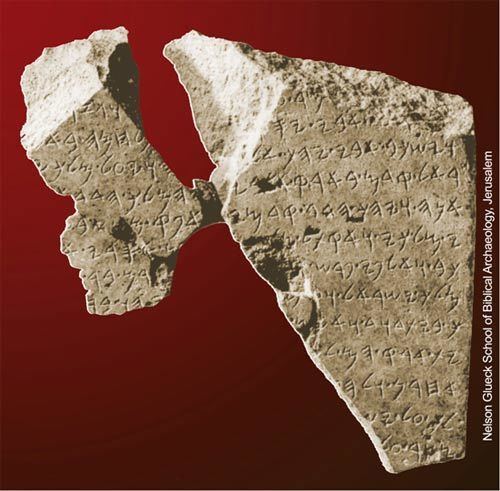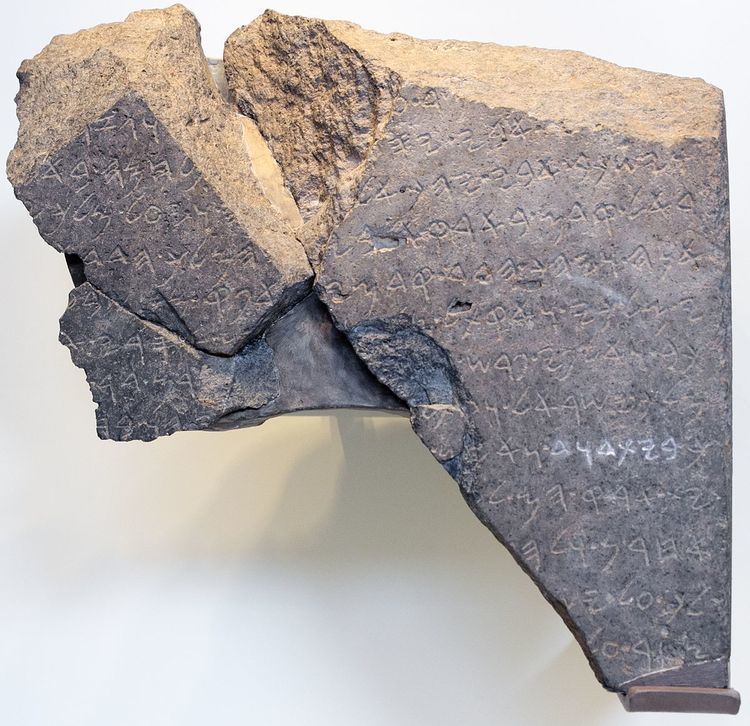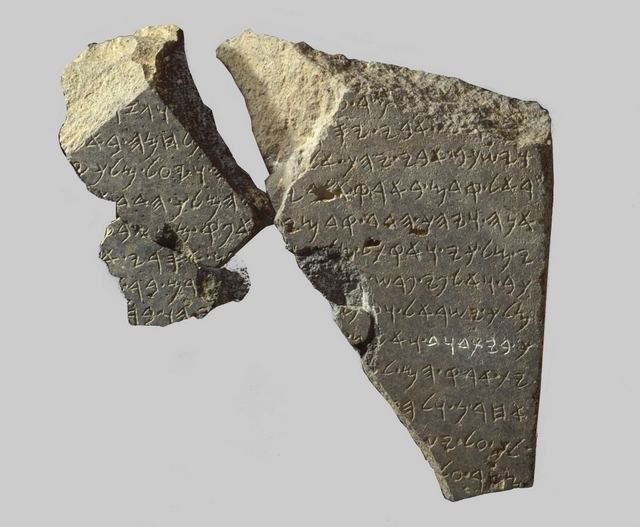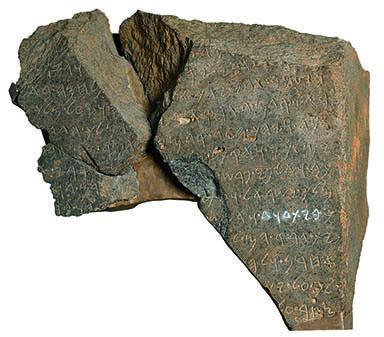Created 870–750 BCE Material Basalt | Discovered 1993–94 Present location Israel Museum | |
 | ||
Writing Old Aramaic (Phoenician alphabet) Similar Mesha Stele, Black Obelisk of Shalman, Kurkh Monoliths, Statue of Ashurnasirpal II, Kilamuwa Stela | ||
Tel dan stele a case for king david
The Tel Dan Stele is a broken stele (inscribed stone) discovered in 1993–94 during excavations at Tel Dan in northern Israel. It consists of several fragments making up part of a triumphal inscription in Aramaic, left most probably by Hazael of Aram-Damascus, an important regional figure in the late 9th century BCE. Hazael (or more accurately, the unnamed king) boasts of his victories over Omri, the king of Israel and his ally the king of the "House of David" (bytdwd). It is considered the first widely accepted reference to the name David as the founder of a Judahite polity outside of the Hebrew Bible, though the earlier Mesha stele contains several possible references with varying acceptance. A minority of scholars have disputed the reference to David, due to the lack of a word divider between byt and dwd, and other translations have been proposed. The stele was not excavated in its primary context, but in its secondary use. The Tel Dan stele is one of four known contemporary inscriptions containing the name of Israel, the others being the Merneptah Stele, the Mesha Stele, and the Kurkh Monolith.
Contents
- Tel dan stele a case for king david
- Tel dan stele 2 kings 9
- Discovery
- Text
- Content
- Configuration
- Cracks and inscription
- Dating
- Authorship
- House of David
- References

The Tel Dan inscription generated considerable debate and a flurry of articles, debating its age, authorship, and authenticity; however, the stele is generally accepted by scholars as genuine and a reference to the House of David. It is currently on display in the Israel Museum in Jerusalem.

Tel dan stele 2 kings 9
Discovery

The stele was discovered by Avraham Biran at Tel Dan in the northern part of modern Israel (fragment A in July 1993 and fragments B1 and B2 in June 1994). The stele was not excavated in its "primary context", but in its "secondary use".
The fragments were published by Biran and his colleague Joseph Naveh in 1993 and 1995.
Text

The following is the transcription using Hebrew letters provided by Biran and Naveh. Dots separate words (as in the original), empty square brackets indicate damaged/missing text, and text inside square brackets is reconstructed by Biran and Naveh:
Content

In the second half of the 9th century BCE (the most widely accepted date for the stele) the kingdom of Aram, under its ruler Hazael, was a major power in the Levant. Dan, just 70 miles from Hazael's capital of Damascus, would almost certainly have come under its sway. This is borne out by the archaeological evidence: Israelite remains do not appear until the 8th century BCE, and it appears that Dan was already in the orbit of Damascus even before Hazael became king in c. 843 BCE.
The author of the inscription mentions conflict with the kings of Israel and the 'House of David'. The names of the two enemy kings are only partially legible. Biran and Naveh reconstructed them as Joram, son of Ahab, King of Israel, and Ahaziah, son of Joram of the House of David. Scholars seem to be evenly divided on these identifications. It is dependent on a particular arrangement of the fragments, and not all scholars agree on this.
In the reconstructed text, the author tells how Israel had invaded his country in his father's day, and how the god Hadad then made him king and marched with him against Israel. The author then reports that he defeated seventy kings with thousands of chariots and horses. In the very last line there is a suggestion of a siege, possibly of Samaria, the capital of the kings of Israel. This reading is, however, disputed.
Configuration
The stele was found in three fragments, called A, B1 and B2. There is widespread agreement that all three belong to the same inscription, and that B1 and B2 belong together. There is less agreement over the fit between A and the combined B1/B2: Biran and Naveh placed B1/B2 to the left of A (the photograph at the top of this article). A few scholars have disputed this, William Schniedewind proposing some minor adjustments to the same fit, Gershon Galil placing B above A rather than beside it, and George Athas fitting it well below.
Cracks and inscription
Bible scholars Cryer and Lemche analyzed the cracks and chisel marks around the fragment, and the lettering towards the edges of the fragments. They noted that if their observations were correct, the stele would most likely have been a modern forgery. However, most scholars consider the inscription authentic.
Dating
Archeologists and epigraphers put the earliest possible date at about 870 BCE, whilst the latest possible date is "less clear", although according to Lawrence J. Mykytiuk it could "hardly have been much later than 750". However, some scholars (mainly associated with the Copenhagen school) – Niels Peter Lemche, Thomas L. Thompson, and F. H. Cryer – have proposed still later datings.
Authorship
The language of the inscription is a dialect of Aramaic. Most scholars identify Hazael of Damascus (c. 842 – 806 BCE) as the author, although his name is not mentioned. Other proposals regarding the author have been made: George Athas argues for Hazael's son Ben-Hadad III, which would date the inscription to around 796 BCE, and J-W Wesselius has argued for Jehu of Israel (reigned c. 845 – 818 BCE).
"House of David"
Since 1993–1994, when the first fragment was discovered and published, the Tel Dan stele has been the object of great interest and debate among epigraphers and biblical scholars along the whole range of views from those who find little of historical value in the biblical version of Israel's ancient past to those who are unconcerned about the biblical version, to those who wish to defend it.
Its significance for the biblical version of Israel's past lies particularly in lines 8 and 9, which mention a "king of Israel" and a "house of David". The latter is generally understood by scholars to refer to the ruling dynasty of Judah. However, although the "king of Israel" is generally accepted, the rendering of the phrase bytdwd as "house of David" has been disputed by some. This dispute is occasioned in part because it appears without a word divider between the two parts. The significance of this fact, if any, is unclear, because others, such as the late Anson F. Rainey, have observed that the presence or absence of word-dividers (for example, sometimes a short vertical line between words, other times a dot between words, as in this inscription) is normally inconsequential for interpretation.
The majority of scholars argue that the author simply thought of "House of David" as a single word – but some have argued that "dwd" could be a name for a god ("beloved"), or could mean "uncle" (a word with a rather wider meaning in ancient times than it has today), or, as George Athas has argued, that the whole phrase might be a name for Jerusalem (so that the author might be claiming to have killed the son of the king of Jerusalem rather than the son of the king from the "house of David".
Other possible meanings have been suggested: it may be a place-name, or the name of a god, or an epithet. Mykytiuk observes that "dwd" meaning "kettle" or "uncle" do not fit the context. He also weighs the interpretive options that the term bytdwd might refer to the name of a god, cultic object, epithet or a place and concludes that these possibilities have no firm basis. Rather, he finds that the preponderance of the evidence points to the ancient Aramaic and Assyrian word-patterns for geopolitical terms. According to the pattern used, the phrase "House of David" refers to a Davidic dynasty or to the land ruled by a Davidic dynasty. As an alternative, Francesca Stavrakopoulou remains sceptical about the significance and interpretation of the inscription and claims that it does not necessarily support the assumption that the Bible's David was a historical figure since "David" which can also be translated as "beloved" could refer to a mythical ancestor. In Schmidt's view it is indeed likely that the correct translation is "House of David."
